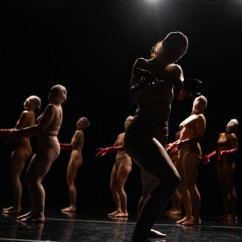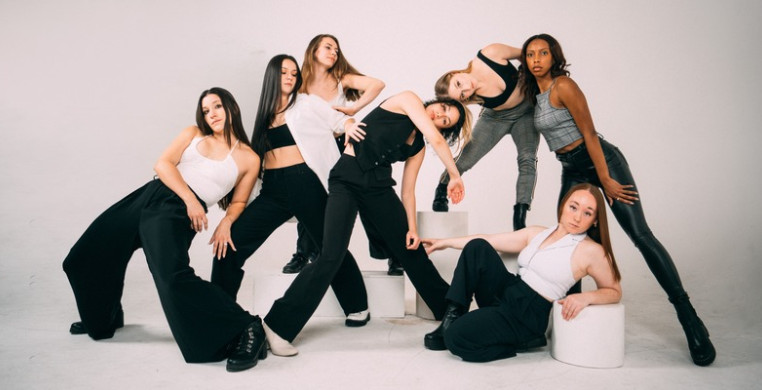Have you ever had a simple conversation transform a stranger into a cherished friend? Or felt a love both tender and painful? When was the last time you felt content alone? These questions underscore humans' remarkable, often mysterious ways to forge and experience connections. From fleeting glances to shared laughter, the range of these emotions reveals the complexity of the human experience. By exploring these intricate relationships, we uncover the essence of what it means to connect on a deeply personal level.
This is the conversation that Hot Crowd initiated with their presentation of “Innate,” which premiered at Theater Wit, May 31-June 2. Through six captivating routines, the program explored various forms of relationships and connections, celebrating the resilience, vulnerability and transformative power inherent in the unique bonds we form.
“Cathexis,” choreographed by Artistic Director Brittany Latta McMahon, delves into the various forms of love that one can encounter throughout life. By spotlighting three different relationships within the routine, McMahon aimed to showcase the true range of this profound emotion, unifying them with the concept of “cathexis”—the investment of mental or emotional energy in a person, idea or object. McMahon herself described “cathexis” within her piece as the “lens through which we can examine the various forms of love in our lives.”
To highlight these contrasting stages of love, McMahon used music to set the tone for each relationship. Each song change brought a dramatic shift in mood and movement: from the dreamy "I Only Have Eyes for You" by the Flamingos, to the joyful "All Shook Up" by Elvis Presley, the haunting "Amara Terra Mia" by Tsar B, and the bittersweet "IFHY" by Tyler the Creator, among others.
The idea of being emotionally invested is always present, with partnered dancers leaning and supporting one another—through moments of sadness and rage. This emotional energy, present within each relationship, showed the foundation of love itself through a desire for an intimate connection. Whether it be the love of a partner or a friend, McMahon celebrated and encouraged this journey of finding and fostering love, even if we lose it.
 "Love Sick" by Katie Carey; Photo by Peter Hinsdale
"Love Sick" by Katie Carey; Photo by Peter Hinsdale
“Love Sick,” choreographed by Katie Carey, was a remarkably haunting performance that tackled the toxic aspects of desire and how some people become trapped within it. The only note in the program was the quote “You may be unable to cast spells with your words, but darling, there is poison on your lips. With one taste I am left love sick.”
The dancers were clothed in nude garments with long, blood-red gloves and a sheer fabric obscuring their faces. This alien appearance heightened the eerie tone set by the echoing vocals and uncanny movements, suggesting a form of love that felt unnatural or tainted.
Much of the movement conveyed a loss of self, as the dancers dragged their bodies across the floor, dug into the air and slapped themselves with an audible airy gasp. It was as if the love they were receiving was tearing them apart from the inside. The dancers struggled to move on from the addictive lust, but in the end, the gloves were removed and the masks taken off—not in unwavering triumph, but with signs of fear. This powerful conclusion highlighted both the strength and the shame of being able to walk away from a love that is harmful.
“When No One Calls” by Emily Rayburn Kamp, performed by Kyra Laster, puts a spotlight on the question “How do you feel when simply sitting alone?”. The work explored one’s relationship with oneself and lightheartedly critiqued the modern comfortability of distractions.
The first half of the routine utilized storytelling and humor to create a personal connection between the soloist and the audience. With three landline telephones on stage, Laster danced with phone to ear, having several conversations with friends and her mother. Her movements exuded coziness, inviting the audience to connect and bask in the familiar atmosphere created by the joking conversations, quirky music and fast-paced choreography.
However, there finally came a time when there was no one on the phone—no more distractions. Laster’s movements slowed and seemed less certain as she circled the empty phone lines in slow graceful leaps, as if expecting a call at any moment. Gradually, her dancing evolved, distancing herself from the landlines, allowing her to explore new movements and unlock a renewed sense of self.
Empowered by this new sense of being, Laster removed the handsets from the landlines—leaving them incapable of receiving incoming calls. After being consumed by life's chaos for so long, she found solace in the present moment and reconnected with herself. The thoughtful ending urged audiences to reconsider their impulse to reach for their phones during moments of stillness and instead reconnect with themselves.
Other pieces featured within the programs include; “Figments (B),” choreographed by Jessi Stegall, which explored the phenomenon of echo chambers in contemporary society through a series of vignettes, “it wants to be heard,” choreographed by Lindsey Scouten, which explored the idea of dissociation from one's inner self and how to remerge these wandering parts of the soul, and “Westside,” choreographed by Spinka-O’Brien, which was a duet that explored the transition of a childhood friendship grown apart.
Each piece brought new movement and themes to explore the various forms of human connectivity to create a very enjoyable evening of storytelling.
For more information about Hot Crowd, click the company link below.


